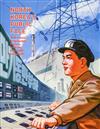| FindBook |
|
有 1 項符合
katharina zellweger的圖書 |
 |
$ 535 ~ 630 | North Korea’s Public Face:20th-century Propaganda Posters from the Zellweger Collection
作者:Katharina Zellweger 出版社:香港大學出版社 出版日期:2018-01-19 語言:繁體書  共 3 筆 → 查價格、看圖書介紹 共 3 筆 → 查價格、看圖書介紹
|
|
|
This catalogue is published to coincide with the UMAG exhibition North Korea’s Public Face: 20th-century Propaganda Posters from the Zellweger Collection.
For most people outside of the Democratic People’s Republic of Korea (DPRK), it may come as a revelation that art is available in North Korea, or that it is a well-developed feature of national culture. As the state guides artistic production, all artists are members of the Korean Artists Federation, and must create a certain number of works each month to receive a salary.
Although the category of ‘Propaganda Artist’ is a lower-ranking designation than ‘People’s Artist’, the propaganda artists are given the vital task of keeping the population informed. Posters first came to prominence during the 1950–53 Korean War and they are still displayed prominently throughout the capital and countryside. Slogans are often taken from statements made by the country’s leadership and from newspaper editorials.
North Korean posters portray a wide variety of topics: from phrases reinforcing party policies to messages reiterating campaigns on culture, public health, education and sports. Works presented in this exhibition primarily illustrate topics related to agricultural development and food production—areas of particular interest based on the years that Katharina Zellweger has addressed food and food security-related issues.
作者簡介:
Katharina Zellweger is a Research Fellow at Stanford University. She first visited North Korea in 1995, as the country was devastated by floods that contributed to a massive famine. As an employee of Caritas, the global Catholic organisation, she was among the first international aid workers on the ground. In the following years, she has made more than fifty trips and visited almost all of the country’s provinces, including the hardest-hit areas usually off-limits to foreigners. In 2006, she was offered a position as country director for the Swiss Agency for Development and Cooperation in Pyongyang. For the next five years, she lived in the North Korean capital and oversaw a series of projects. Her five-year tenure in Pyongyang coincided with a period in which North Korea gradually began to experiment with elements of economic reform, including private plots for farmers to grow and sell crops on the open market and the introduction of an incentive system to boost production.
|










